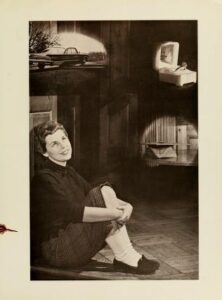As Woman’s College (now UNCG) moved into the 1960s, the school was on the precipice of enormous change. It was a time of political and social unrest in the country and in the community, but the campus yearbook, Pine Needles, did not always reflect this turmoil. In the late 1950s and early 1960s, Pine Needles retained a more traditional format, including photographs of campus buildings, school organizations, sports, and individual student portraits. These yearbooks also tended to represent a more conventional view of women’s roles in society. Images of female students dreamily pondering graduation, shiny new cars, and engagement rings, occupied many of the pages. Local events, such as the Woolworth Sit-ins of February 1960 and the Tate Street protests, were noticeably missing from the publications. Yet, there was a sense that Woman’s College students were moving toward greater self-awareness. The make-up and mindset of the student body was evolving, and soon the yearbook would become more of a reflection of the times.
One of the most significant changes on campus during the 1960s was the admittance of male students. The school had been a women’s college since it opened in 1892, but in the fall of 1964 it opened its doors to men and officially became The University of North Carolina at Greensboro. During the first few years after this shift, there was very little evidence in the yearbooks that men had been integrated into campus life. It took several years before male students were fully assimilated into the student body and were equally represented in the yearbook.
The 1960s and 1970s ushered in a more political era on the UNCG campus, and this shift was reflected in the yearbooks. Political cartoons and realistic photographs peppered the Pine Needles of these decades. Presidential elections and campus protests were prominently featured. President Richard Nixon was a particular target of student artists on the Pine Needles staff and he was lampooned in several volumes. These highly charged drawings echoed the art of political cartoonists such as Paul Conrad, who was chronicling current issues such as Watergate, civil rights, and social injustice in national publications. Pine Needles not only covered national events, but also those closer to campus, such as the Black Power Forum, which was included in the 1969 yearbook. It also continued to include images of students, campus views, and school sports, as well as visiting bands and entertainers.
In the decades after the college became co-educational, it was still trying to come to terms with its new identity. UNCG had embraced the male students and campus expansion, but because of its lack of social opportunities and adequate dormitories, many considered the school to be a “suitcase college” or commuter school. The administration actively sought ways to bring the students back to campus. A survey of the student body reflected a strong interest in bringing national fraternities and sororities to the university. From the time that the school opened, these types of social organizations had not been welcomed by the administration. Charles Duncan McIver, the founder and first president of the college, had considered them elitist, and instead instigated literary societies. Fraternities and sororities were finally approved by the faculty and trustees, and the first membership rush took place in 1980; the same year that the school exceeded a 10,000 enrollment.
When the school celebrated its 100th birthday, the event was chronicled in the 1992 Pine Needles. But sadly, this centennial edition would be one of its last. Budgetary constraints and general student apathy heralded the demise of the yearbook, and the last volume of Pine Needles was published in 1993.
However, the yearbooks remain a popular and heavily researched part of the archival collection at UNCG. Each volume serves as a time capsule of fashion, school traditions, campus scenery, and student life. Most importantly, these yearbooks have recorded and commemorated the history of the school, from its beginnings as a woman’s teaching college to its current place as a vital public liberal arts and research university.
By Kathelene McCarty Smith
